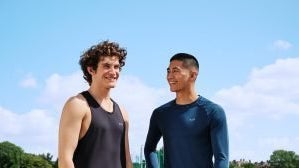
Unless you’re a deadlift fanatic or you train using a sport-specific training programme, chances are that your hamstrings are one of the more neglected muscle groups in your body. This may be due to the simple reason that the hamstrings are not as visible as other ‘mirror muscles’, or maybe you don’t feel like you know enough hamstring exercises or the correct way to approach training them.
Nevertheless, poor hamstrings development and imbalanced quadriceps-to-hamstrings strength ratio increase the risk of certain knee injuries that could take you out of training and sport for a long period to recover. Providing your hamstrings with sufficient direct training stimulus will not only help you to achieve a more balanced looking physique but will also significantly improve your sports performance and reduce the risk of certain injuries.
What are your hamstrings?
The hamstrings are a large muscle group on the posterior aspect of your upper leg, below your glutes. They consist of three main muscles;
Semitendinosus – this muscle runs medially (closer to the inside of your leg) from its attachment on the pelvis to the tibia.
Semimembranosus – this muscle also runs medially on the back of the thigh, buried beneath the semitendinosus. It also runs from its attachment on the pelvis to the tibia.
Biceps Femoris (Long Head and Short Head) – the long head of this muscle runs superficially (closer to the skin) to the short head, with its attachment running from the pelvis to the fibula, while the short head runs from its attachment on the femur to the fibula. The biceps femoris is the most lateral (nearest to the outside of the leg) of the hamstrings.
Why are your hamstrings important?
The main functions of the hamstrings are knee flexion and hip extension, so it’s important to incorporate both compound and isolation exercises that load these movements to optimally develop the hamstrings.
While it’s not possible to work specific muscles in isolation, research shows that altering your foot placement/angle can influence which muscles in the hamstrings are made to work the hardest, known as ‘preferential activation’. Turning your feet with your toes facing inwards during an exercise such as a hamstring curl will result in preferential activation of the medial hamstrings (semitendinosus and semimembranosus) while turning your feet with your toes facing outwards will result in preferential activation of the biceps femoris.
Due to the large range of motion afforded by the hamstrings, it is also important to strengthen the muscles throughout their full range of movement. This means exercising your hamstrings at different lengths and through their full range.
Our 5 Most Difficult Hamstring Exercises
Nordic Hamstring Curls
Muscles Targeted: Hamstrings
Equipment Required: Bodyweight & Partner/Anchor point
Technique: Start in a kneeling position, with your hips extended (so you’re only bent at the knee). Find a suitable anchor for your feet/ankles – ask a friend/partner to use their body weight and hold you down, or find a secure and stable item/surface that will do the job (make sure your ankles are protected so you don’t get injured). Contracting your hamstrings against the anchor (as if you are trying to flex your knees), slowly lower your body to the floor, whilst bending minimally at the hip. Use your arms to help press yourself back to the start position (it’s all about the eccentric phase in this exercise!). Perform 3-5 sets of 3-5 reps, around 2-3 times per week for optimal adaptations.
As a beginner-friendly version, only perform the lowering to the floor part of the exercise. If you manage to get highly advanced with this exercise, then try the curl part where you contract your hamstrings to return yourself to the start position.
2. Stiff-Leg Deadlift
Muscles Targeted: Hamstrings, Glutes, Spinal Erectors
Equipment Required: Barbell & Plates or Dumbbells
Technique: Start with the barbell resting on the floor and stand with your feet either around shoulder-width apart, or slightly narrower so that they are directly beneath your hips. Your feet should be underneath the barbell with the bar over your midfoot (and your bodyweight spread across your whole foot, not just on the heels or ball of your foot). Grab the bar on the knurling (the rough part, using the innermost bands), ideally using hook grip, but mixed grip or overhand with or without straps is fine too. Bend slightly at your knees, then flex at the hips, maintaining a neutral/flat back angle. Keeping your arms loose but your grip tight, extend at your hips until you can lockout at the top, then lower the bar to the start position. The bar should remain close to the body throughout the lift, so it’s important to engage your lats to pull the bar close to your centre of mass.
3. Good Mornings
Muscles Targeted: Hamstrings, Glutes, Spinal Erectors
Equipment Required: Barbell & Plates
Technique: Start with the bar on your back/shoulders, as if you were going to perform a barbell squat. With a slight bend in your knees, flex only at the hips so that your torso is approaching parallel with the ground. Once you feel a stretch in your hamstrings, extend at your hips to return to the start position. Make sure you maintain a neutral back angle throughout this exercise and use moderately light weights so that technique and proper form is not compromised.
4. Hamstring Sliders
Muscles Targeted: Hamstrings
Equipment Required: Bodyweight & Flat Surface
Technique: Start by lying supine (on your back) on the floor. You’ll need to have a smooth floor like laminate flooring and wear socks (or if you have carpeted floors, then put something like a magazine between your heels and the floor so that you are still able to slide). Get into a glute bride position by pulling your heels back until they are directly below your knees and push your hips up towards the ceiling. From here, slide your heels away from your hips until your legs are nearly straight, then (still sliding) pull your heels back to the start position. Make sure you are pulling your heels into the floor throughout this exercise to keep your hamstrings engaged.
Increase the difficulty of this exercise by slowing it down, doing it with one leg or by introducing isometric holds at different angles.
5. Hamstring Curls
Muscles Targeted: Hamstrings
Equipment Required: Hamstring Curl Machine
Technique: Sit or lie down in the hamstring curl machine, with the attachment in contact with your Achilles tendon. Set the loading pin to an appropriate weight, then pull your heels back towards your hips against the resistance of the machine. Slowly return to the start position in a controlled manner, then initiate the following rep.
This can also be performed using a resistance band at home by anchoring one end of the band to a secure anchor point, then performing the exercise as you would in a gym (using a chair or lying prone on the floor).
Take Home Message
Remember, to achieve optimal adaptations to your hamstrings, you’ll need to vary the stimulus. Use light/moderate loads on each of these exercises with greater volume to make hypertrophy adaptations (add muscle size), and also use higher loads with lower volume for strength gains.








